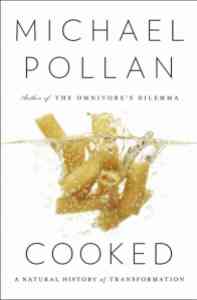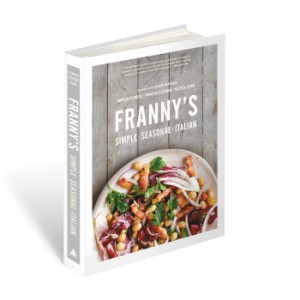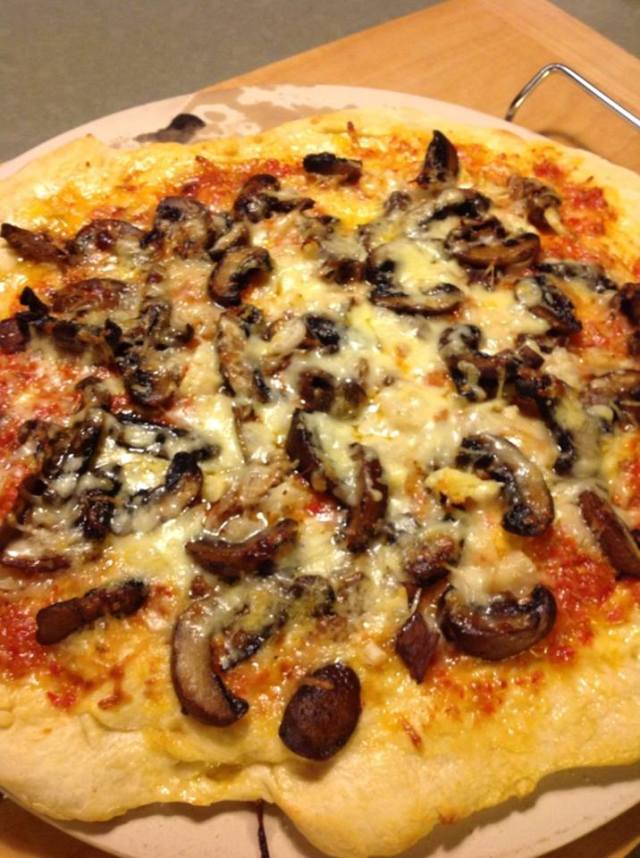One of the things I love about Barbara Kingsolver’s Animal, Vegetable, Miracle is that, even though her project is big, it inspired me to become a vegetable gardener. Somehow she breaks it down and makes it seem like an ordinary activity. Although she does it on a much larger scale than I ever will, she brought me into an activity that I really thought up to that point was beyond me. And it has changed my life, really, especially the way I cook and eat and think about food.
 Unfortunately, Michael Pollan’s book Cooked is having the exact opposite effect. I can actually cook. I’m utterly untrained (you should see me chop an onion) and also, although I enjoy it a little bit, I am not an enthusiastic cook. I am an impatient cook (see: dumping whole carton of half and half into chocolate tart without checking the recipe). I like things to taste good but without a whole day’s worth of effort. And if I’m going to put in the day’s worth of effort (see: 6-hour pork braciole and sauce), I only want one or two easy people to come over and share it, because I’m going to be exhausted.
Unfortunately, Michael Pollan’s book Cooked is having the exact opposite effect. I can actually cook. I’m utterly untrained (you should see me chop an onion) and also, although I enjoy it a little bit, I am not an enthusiastic cook. I am an impatient cook (see: dumping whole carton of half and half into chocolate tart without checking the recipe). I like things to taste good but without a whole day’s worth of effort. And if I’m going to put in the day’s worth of effort (see: 6-hour pork braciole and sauce), I only want one or two easy people to come over and share it, because I’m going to be exhausted.
Before Christmas, I was feeling particularly uninspired about cooking. That is why I asked for Michael Pollan’s new book, separated into “Fire, Water, Air, Earth” and sure to inspire me in all sorts of ways about barbecue, stews, bread and fermenting. But all it’s done is frustrate me.
I did like the introduction. It was full of great quotes and philosophy about reconnecting with cooking and the importance of home cooked meals. It was a celebration of this place we are in now as a society, turning from processed foods and reconnecting with real food.
But about 20 pages into the chapter on barbecue, I was really tired of hearing about how to slow cook a whole pig. This is something I will never do, and although it is clearly a way of life for some families in the South who own barbecue joints, it hardly counts as “home cooking.” It is also not a way of life that will be around for very long; as soon as this family, who continue due to a grandfather clause, retire, no one else will be able to get a permit for such a dangerous operation. Flipping through the chapter, it looks like they’ll be moving on to taking the gigantic barbecue on the road.
So I moved on to “Water.” And I smiled at the first sentence: “Is there anyone alive who actually enjoys chopping onions?” Because when I actually did learn to cook– and I credit Moosewood Cooks at Home for my beginning education– the first thing I learned was that every recipe begins with chopped onion and garlic sautéing in oil.
That may not seem like a big revelation, but it was to me. From there, it was basically a matter of cuisine/spice: Greek, Italian, Spanish, Moroccan, Indian, Asian. Depending on the direction you were going to take the meal, you’d need: feta, tomato, lemon and olives; tomato, basil and oregano; potato, saffron, paprika and gruyere; chickpeas, tomato, lemon, cumin, and turmeric; curry, coconut milk, and garam masala; or soy sauce, hoisin, ginger and Thai curry paste. But you would always need garlic and onion. Always.
But then he brought in his friend Samin to help him learn to cook. She seems like a very nice woman, a large personality, and an excellent cook. She got her initial training (after her Iranian mother) by becoming a busier at Chez Panisse. And her motto is that cooking takes “three ‘p’s: patience, presence, and practice.”
Great cooking, such as she is teaching him, takes a lot of time and thought. The deeper I get into the chapter, the more I feel like shouting: “Oh, sure, if you teach at Berkeley and this is your book project and you’re Michael freakin Pollan, go ahead, make a mirepoix!”
I have trouble giving onions in a pan the ordinary “cook 10 minutes until translucent.” These two would never think of sautéing those onions for less than 30 minutes. Thirty minutes! And watch them because they need to caramelize but not burn! There’s very good reason for this, which Pollan tells you.
You also should liberally salt your meat before browning. They tell you how to do this, too. And do it two days ahead or at least 12 hours ahead or don’t do it at all. There’s a very good reason to do this, too. Once you know what it is, you’ll feel guilty for not doing it and eating less flavorful meat.
I hate the word “mirepoix.” I had to go to the online dictionary to figure out how to pronounce it (meer-pwah), although I don’t plan on ever saying it. It’s a fancy word for sautéed celery, onion and carrot (or other veggies and herbs) used as a base for stew or soup. I also hate the word “soffritto,” which means the same thing.
I do like the history of cooking, and the story of the invention of the clay pot and how most stews are about making the worst cuts of meat taste really good. But it feels like we’ve come a really long way, at least in terms of wealth and leisure, if we can cook like this. And it’s not something home cooks can do all the time. This book makes the best case for restaurants of any book I’ve ever read.
 For a breather, I turned to another book I got for Christmas, the cookbook Franny’s: Simple, Seasonal, Italian. I was a little nervous because the foreword was written by Alice Waters of Chez Panisse. I skipped the foreword. The book has beautiful photos and a big section on pizza. Ah, yes. I have complained about pizza in Central Minnesota for years and spent some time Christmas break introducing Steve to good pizza in Chicago.
For a breather, I turned to another book I got for Christmas, the cookbook Franny’s: Simple, Seasonal, Italian. I was a little nervous because the foreword was written by Alice Waters of Chez Panisse. I skipped the foreword. The book has beautiful photos and a big section on pizza. Ah, yes. I have complained about pizza in Central Minnesota for years and spent some time Christmas break introducing Steve to good pizza in Chicago.
Though I don’t have a wood-fired brick oven, I had hope I could make good dough following their directions.
It is made of the usual: yeast, water, flour, salt. They direct you to let the yeast dissolve and sit about 5 minutes until foamy. Then with a dough hook, beat in flour and salt 2-3 minutes. Do not knead. Then you put the dough in an oiled bowl covered loosely with plastic, at least 24 hours and up to 48 hours. When you’re ready to make the pizza you shape the dough, put on a baking sheet and refrigerate again at least 4 hours, and up to 12 hours. HEY! I thought we were READY to make the PIZZA!
I will not be making this, though I do hope to eat at Franny’s, the restaurant, when we go to Brooklyn in March. And, you know, maybe I’ll make this, for my birthday or something. I suppose I could get in the habit of making the dough every Tuesday for a weekly Friday night pizza in the summer. Salting the meat on Thursday for our Saturday stew. I’m going to need another calendar.
So… I’m wondering if I need to keep that fermenting crock and weights on my Amazon wish list or if I should just move on. I am going to read all about it in Michael Pollan’s book and then decide, after I find out about bread baking.
Meanwhile, I used the whey from the ricotta I made New Year’s Eve for this delicious pizza crust. I did not heat my pizza stone for an hour at 500 degrees as recommended by Franny’s, but I do think it made a great crust even at 375 for 20 minutes while I assembled everything. And for toppings, I slathered it with my canned red pepper sauce and topped it with sautéed onion (of course), garlic, mushrooms, gruyere and parmesan. It was amazing. And I made it from scratch in under an hour.




Enjoyed the blog this morning.